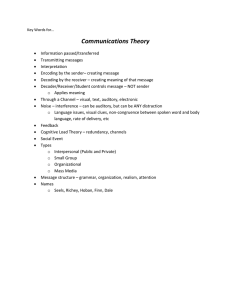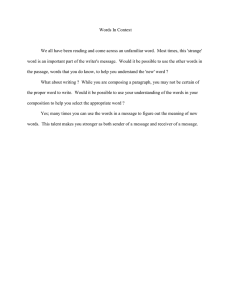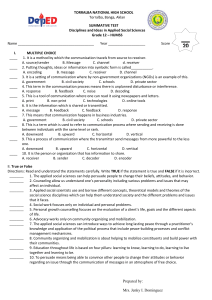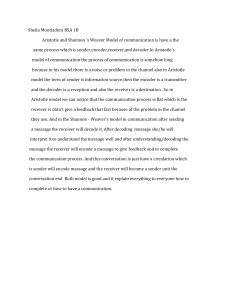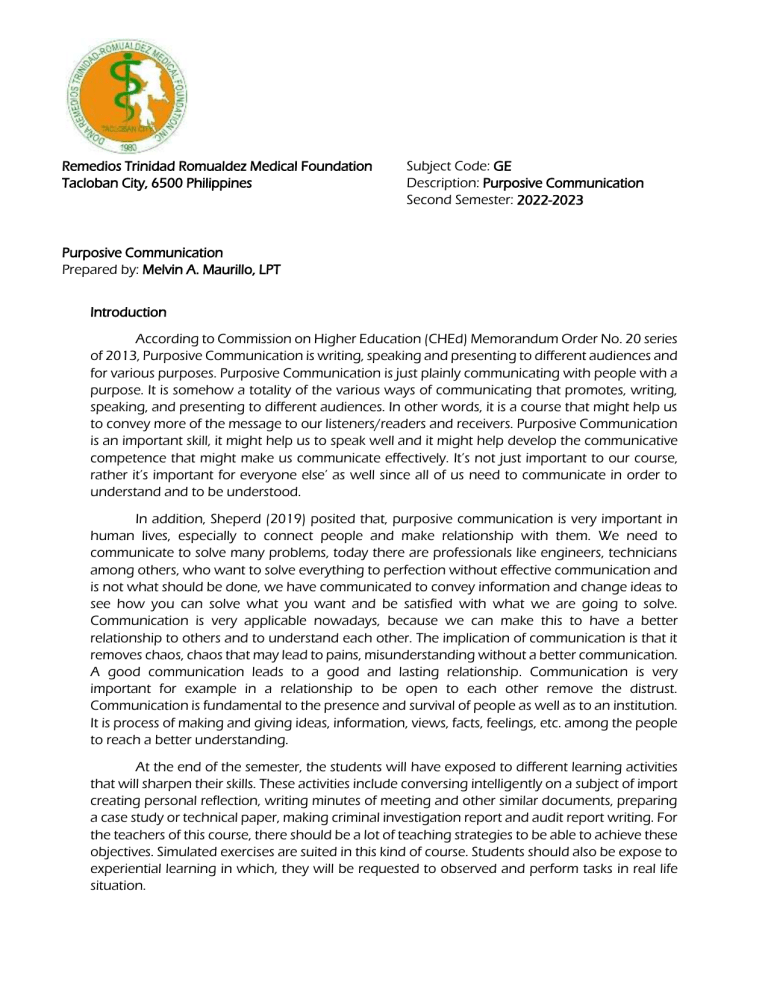
Remedios Trinidad Romualdez Medical Foundation Tacloban City, 6500 Philippines Subject Code: GE Description: Purposive Communication Second Semester: 2022-2023 Purposive Communication Prepared by: Melvin A. Maurillo, LPT Introduction According to Commission on Higher Education (CHEd) Memorandum Order No. 20 series of 2013, Purposive Communication is writing, speaking and presenting to different audiences and for various purposes. Purposive Communication is just plainly communicating with people with a purpose. It is somehow a totality of the various ways of communicating that promotes, writing, speaking, and presenting to different audiences. In other words, it is a course that might help us to convey more of the message to our listeners/readers and receivers. Purposive Communication is an important skill, it might help us to speak well and it might help develop the communicative competence that might make us communicate effectively. It’s not just important to our course, rather it’s important for everyone else’ as well since all of us need to communicate in order to understand and to be understood. In addition, Sheperd (2019) posited that, purposive communication is very important in human lives, especially to connect people and make relationship with them. We need to communicate to solve many problems, today there are professionals like engineers, technicians among others, who want to solve everything to perfection without effective communication and is not what should be done, we have communicated to convey information and change ideas to see how you can solve what you want and be satisfied with what we are going to solve. Communication is very applicable nowadays, because we can make this to have a better relationship to others and to understand each other. The implication of communication is that it removes chaos, chaos that may lead to pains, misunderstanding without a better communication. A good communication leads to a good and lasting relationship. Communication is very important for example in a relationship to be open to each other remove the distrust. Communication is fundamental to the presence and survival of people as well as to an institution. It is process of making and giving ideas, information, views, facts, feelings, etc. among the people to reach a better understanding. At the end of the semester, the students will have exposed to different learning activities that will sharpen their skills. These activities include conversing intelligently on a subject of import creating personal reflection, writing minutes of meeting and other similar documents, preparing a case study or technical paper, making criminal investigation report and audit report writing. For the teachers of this course, there should be a lot of teaching strategies to be able to achieve these objectives. Simulated exercises are suited in this kind of course. Students should also be expose to experiential learning in which, they will be requested to observed and perform tasks in real life situation. Module 1: Communication Process, Principle, and Ethics Learning Outcome Based on the Course Syllabus 1. Apply the nature, elements, and function of verbal and non- verbal communication in various and multicultural contexts through different learning activities (concept mapping, personal reflection). Learning Objectives At the end of the module, the following learning objectives will be attained by the students with at least 75% accuracy: 1. The students will be able to describe communication models through concept map. 2. The students will be able to identify the various types of communication. 3. The students will be able to illustrate the principles of effective communication by giving personal example. Course Direct Instruction Communication Models In this area, the students will be informed of the different process, principles and ethics in communication. This will be helpful in nurturing their minds to be more equipped and more knowledgeable in communicating expertly in their field. Moreover, it will be a good starter to prepare themselves with ethical behavior and professional manner. According to Chand (n.d.) communication is a process concerning exchange of ideas between a person with different positions in an organization to achieve mutual harmony. The process of communication is dynamic rather than static phenomenon. Mandrunio and Martin (2018) presented the following communication models. 1. Aristotle’s Communication Model. Aristotle emphasized that there are three variables in communication process: speaker, speech and audience as illustrated in the communication flow below: a. Speaker - Always remember that the speaker variable here is very significant. If there is no speaker, there will be no speech to produce. The speaker adjusts his/her speech defending on the profile of student. The audience demographics such as age, sex, background, culture, race, religion, gender, social and economic status and political orientation or inclination and among others should be considered. Even beliefs views and attitudes also play an important role when talking about audience consideration since oftentimes, the audience bring these with them when they decode a message in any given situation. b. Speech - is human vocal communication using language and also means of communication used by people. It is the expression of ideas and thoughts by means of articulate vocal sounds, or the faculty of thus expressing ideas and thoughts. c. Audience - is the person who receive the message, either a reader or a listener. It is also the person for whom a writer writes, or composer composes. In other words, audience refers to the spectator’s listeners, and intended readers of a writing, speech, or performance. FFDGCVCXZCZ Speaker XCGGSSSS FFDGCVCXZCZ Audience XCGGSSSS FFDGCVCXZCZ Speech XCGGSSSS d. Example of Aristotle’s Communication Model - Teacher Alice was expecting that her students will submit case study which is there semestral output. Unfortunately, most of them did not submit. Alice called the attention of the students who were not able to submit and reminded them that their final grade depends on their participation, semestral outputs, and etc. Speaker: Teacher Alice Speech: About semestral output Audience: Students 2. Laswell’s Communication Model - a well-known speaker, Harold Dwight Laswell described communication as being focused on the following Ws: Who says What in Which channel to Whom and with What effects as seen in the model below: a. Communicator - this is a person who is able to convey and exchange ideas, news, or information. Also, someone who is able to talk about their ideas in a way that other people understand. b. Message - is a short piece of information that you give or send to a person when you cannot speak to them directly. Message is also the main idea in an advertisement speech, etc., or something that you want to tell. c. Medium - is a system of communication, by which information (the message) is transmitted between a writer or speaker (the sender) the audience (the receiver). The medium used to send a message may range from an individual’s voice, clothing, writing and body language to forms of mass communication such as television, newspaper, and the internet. d. Receiver - is the person who receive the message. He is the observer, reader, and listener. The receivers’ task is to interpret the sender’s message, both non-verbal and verbal. e. Effect - is the response we elicit from the recipient of our communication. It is also the response of the sender whether positive or negative. Who Communicator f. Say what Message in which Channel Medium to whom Receiver with what effect Effect Example of Laswell’s Communication Model - GBP NEWS: A water leak from Bayowg’s tsunami crippled atomic power station resulted in about 100 times the permitted level of materials flowing into the ocean, operator Taclobanon Electric Power Co. said on Saturday. The process of communication begins with the communicator (who) sending a message (what) using a medium (in which effect) afterwards. The content sent, the medium used, as well as the effect on the recipient of the message may be analysed through this model. While this model is similar to Aristotle’s the sense that job is liner and have the same components, Laswell’s also differs in that there are five involved, with the addition of two: medium and effect. Who : Taclobanon Electric Power Co Operator What : Radioactive material flowing into sea Channel: GBP NEWS (Television medium) Whom : Public Effect : Alert the people of Bayowg from the radiation 3. Shannon-Weaver’s Communication Model - Claude Elwood Shannon and Warren Weaver’s model is another communication model, a year after Laswell’s for Bell laboratories. It was conceptualized for the function of the radio and television that serves as a model for technical communication and, later in, adopted in the field of communication. In this model, other factors such as noise, reception, destination, and feedback have been identified. Other terms such as information source the communicator, transmitter for the encoder, decoder, (reception), and receiver (destination) were introduced. a. Sender - is the main source of the message or the person who originates the message and the sends it to the receiver. b. Encoder - the one who develops and sends the message to. The encoder must identify how the message will be received by the audience or receiver, and make adjustments so the message is received the way they want it to be received. The encoder uses a medium to send the message- a text message, email, phone call, face-to face meeting, or other communication tool. c. Decoder - the audience decodes or interprets the message for themselves. Decoding is the process of turning communication into thoughts and ideas. You may realize that you are hungry and encode the following message to send to your roommate: “I’m hungry. Do you want to get some pizza today?” As your roommate receives the message, they decode or interpret your communication and turn it back into thoughts to make meaning. d. Example of Shannon - Weaver’s communication model- Sieg made call to his friend ‘’ come here I want to see you” During his call, noise appeared (transmission error) and his friend received ‘’ I want’’ only. Again friend asked Sieg (feedback)’’ what do you want Sieg’’ Sender : Sieg Encoder : Telephone (Sieg) Channel : Cable Noise : Distraction in voice Decoder : Telephone (Friend) Receiver Friend 4. Berlo’s Communication Model - David Berlo’s model is probably the most well-known among the communication models. Initially, this model was called SMCR which stands for sender the message, sent through a channel or medium to a receiver. However, it was revised later on to include noise, hence the acronym SMCRN. The major variables involved in the communication process are (1) source, (2) message and (3) channel, and (4) receiver. a. Source - the source being the originator of the message acts the encoder. As such, the encoder should practice communication skills such as listening, speaking, reading, and b. c. d. e. writing. His/her attitude towards the audience of the subject as well as he/she is in which includes values, beliefs and practices, and culture. Message - the second variable which is message is composed of content; elements such as the language used and gestures employed, treatment of the manner by which the message is transmitted; and structure which refers to the arrangement of parts or flow of the message. This code shows how the message is being sent; that is the language (verbal code) used and the accompanying gestures (non-verbal code) employed. Remember that there should be no mismatch between the verbal and nonverbal codes. Channel - the third variable which is channel referred to the various senses, hearing, smelling, tasting and touching. Receiver - finally, the last variable id receiver, the one who decoded the message. Remember that the components of this last variable are similar to those of the first since for communication to be effective both the source and the receiver should have good communication skills. Example of Berlo’s Communication Model - Zach is a dedicated and passionate teacher. He uses strategies during discussion and employs different languages and gestures. He also conducts activities that students’ senses are used. Source : Zach Message : Language and gestures Channel : Activities and senses used during discussion Receiver : Students Types Communication Madrunio and Martin (2018) stated the 3 types of communication according to mode, communication according to Context and Communication according to purpose and style. 1. Types of Communication according to Mode a. Verbal-Non-Verbal Communication - a message may be conveyed via these types. Even though communication is often thought of as verbal, the nonverbal mode is equally essential as it enhances one’s message. b. Visual Communication - uses visuals to convey information and/or messages. 2. Types of Communication According to Context a. Intrapersonal Communication - this means talking to oneself. Some people label it as self or inner talk, inner monologue and dialogue. This occurs within mind or self. b. Interpersonal Communication - this is an interactive exchange takes place as interpersonal communication takes place. It involves relationship between persons. c. Extended Communication - involves the use of electronic media like mobile phones, computer, tablet and etc. d. Organizational Communication - this type of communication according to context focuses on the role that communication plays in organizational contexts. e. Intercultural Communication - this is a communication between or among people having different linguistic, religious, ethnic, social and professional backgrounds. 3. Types of Communication According to Purpose and Style a. Intrapersonal Communication - this means talking to oneself. Some people label it as self or inner talk, inner monologue and dialogue. This occurs within mind or self. b. Informal Communication - certainly does not employ language. Principles of Effective Communication According to the article of Vicky (2018), lack of effective communication renders an organization handicapped. The following are the principles of effective communication: 1. Clarity - the message must be understood by the receiver. The words used should be simple. The language hence it should not create any confusion that may leads to misunderstanding. Language is the tool of communication; hence it should be clear and understandable. “When a reader is asked what qualities, they value most in writing, people who must read a great deal professionally put clarity and adequacy at the top of their list. If they have to invest too much effort in figuring out writer’s meaning, they will give up in dismay and frustration. 2. Adequacy and Consistency - the sender must carefully take into account that the information to be communicated should be complete and adequate in all respect. Inadequate and not complete message leads confusion and delays the action to be taken. Sufficient information must be consistent with the organizational objectives, plans, policies and procedures. The message which is inconstant may play great confusion and distort the corporate interests. 3. Integration - this principle which is integration explains that because of communication the efforts of human resources of the organization should be integrated towards achievement of corporate objectives. The significant aim of communication is to achieve the set target. 4. Economy - the inessential use of communication system will add to cost. The system of communication must be used effectively, timely i.e. at the appropriate time and when it is necessary. The use of communication system can be achieved in the economy this way. 5. Feedback - the purpose of communication will be defeated if response is not taken from the receiver. The confirmation of the receiver of the message in its right perspective from its receiver fulfills the object of communication. The feedback is significant only in case of written communication and messages sent through messengers. In case of oral type of communication, the feedback is immediately identified. 6. Need for Communication Network - for effective communication this network is essential. The managerial effectiveness also depends upon availability of adequate network. The route through which the communication passes from sender to its receiver refers to communication network. 7. Attention - the message communicated must draw the attention of the sender or receiver staff and ensure action from him in the right perspective. The efficient conveying. As posited by Mandrunio and Martin (2018), since communication is two-way process, it is important that you know the principles to be observed to make it effective. For both verbal and written communication, you should be able to apply the following principles: 1. Know your purpose in communicating. Are you communicating basically to inform, to entertain, to persuade? While you make have more that purpose, there is still a more dominant objective or reason why you communicate. 2. Know your audience. In both speaking and writing, you should know your audience as it will dictate the speaker or writing style you are going to employ. You have to consider the age, educational background, professional, culture, and other salient features of your listeners or readers. 3. Know your topic. You communicate essentially because you want to share something. You may then utilize several or multiple communication techniques to easily catch the attention of the audience. 4. Adjust your speech or writing to the context of the situation. The environment in which your speech and writing is to be delivered determines the kind of language you will use. 5. Work on the feedback given you. Take kindly to criticisms. In the long run, constructive criticisms will prove beneficial to you as you learn to address them. Ethics of Communication Mandelbaum (2019) posited that, ethical communication is type of communication that is predicated upon certain business values, such as being honest, concise, and responsible with one’s words and the resulting actions. As a set of principles, ethical communication considers that one’s thoughts must be conveyed and expressed effectively and exactly, and that the resulting actions or consequences will potentially be based solely on how the message was communicated. Meanwhile, ethical communication defines a framework or set of acceptable communication principles that align with an enterprise’s overarching code of conduct or code of ethics. Mandelbaum (2019) the following examples of how ethical communication can change the outcome of a problem in a business or workplace environment, revealing why ethical communication principles should be followed: 1. Medical Industry. In the medical industry, there lot codes of ethics that medical professionals have to follow, with regard to their actions and communication. This principle makes sure that all patients and fellow medical professionals have their rights protected. 2. Property Consulting Industry. Ethical communications in the property consulting industry can take several forms, including revealing key pieces of information to would be home owner of a property including “negative” truths about the property. 3. Marketing Industry. In the marketing industry, ethical communication can include revealing to clients that their business marketing applications are not optimal, and that a cheaper vendor, or a different from of marketing, will yield better results. Virtually every industry can benefit from ethical communication principles, which always seeks to ensure that every enterprise member is able to present valuable pieces of details so that the best decision can be made.

